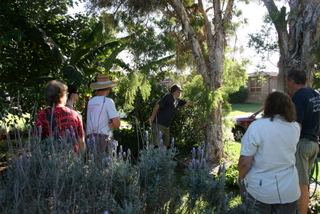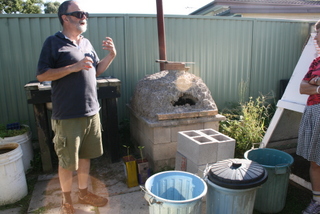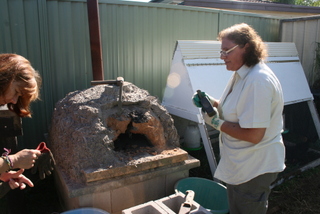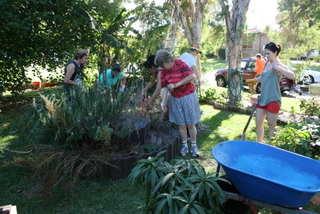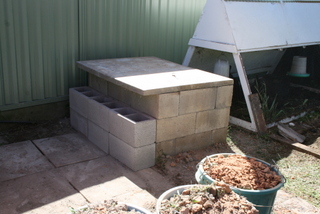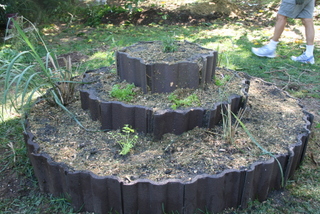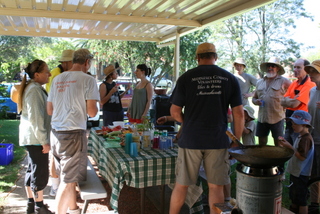What is a blitz, I hear you ask? A blitz, or to use its full title “permablitz” is where a group of Permaculture people (“permies”) get together at someone’s place and hack, chop, dig, construct, shred and generally do stuff to your garden to help you live more sustainably. We hosted one recently with Permaculture Sydney West (PSW) and they are a great thing. Stuff that would take you a couple of weeks to do by yourself (or you couldn’t do by yourself) is accomplished in a couple of hours. We got trees trimmed, shredded and mulched, firewood (next years’) cut, the old cob pizza oven deconstructed and the herb spiral redeveloped, all in a matter of hours.
It is wonderful to have all these people get together to help you out and hopefully learn something into the bargain, and it is traditional for the host to put on lunch to thank them. To get the most out of your permablitz experience for the least stress, here is what we found helped -
Plan – this is your blitz and to get the most out of it a plan is necessary, vague instructions to fit in a banana circle “over there” or a mandala garden somewhere in your back yard will only frustrate and reduce the effectiveness of your willing helpers. In the best of all possible worlds you would have your Permaculture design in your hand so you could pick two or three projects to kick off. In any case make sure YOU know what you want done and where you want it done and you can communicate it to the other permies.
Prepare – Falling out of the plan is what you need to do to prepare for the blitz. This mostly means having any needed materials on hand, if you want a herb spiral you will need materials like bricks, stone or tiles to build it out; fertile organic material to fill it with, herbs to plant out in it and mulch to finish it off with. You may also need to get hold of any special tools that are not likely to be part of the average tool kit such as a brick saw if you will be cutting up bricks for borders or to build a herb spiral, a chain saw if heavy duty cutting is required or a biiiiig mulcher to handle organic material trimmed off trees or cleaned up out of the garden. If it is likely to be one off use it would be best to borrow or rent any big stuff.
Supervision – you are likely to get a mix of people to any blitz with different levels of knowledge, skill and physical ability so supervision is important. We find you get the best result from your people if you split them into teams and have at least one experienced person in each team who is capable of keeping people focussed in the right direction. You (the host) need to be free rather than getting down into the nitty gritty work (as hard as that is!) so you can keep an eye on all the teams and make sure they are sticking to your plan. You also need to be available to answer technical (or non technical as the case may be) questions on how, where or what you want done.
Safety – Before starting out it is always a good idea to check tools, especially power tools to make sure they are OK before use. If the group does not have their own first aid kit it is a good idea to have one of your own floating around within easy reach just in case and some spare sunscreen, gloves and safety glasses always go down well with your willing workers.
Food – As mentioned earlier it is traditional for the host to put on a feed to thank everyone for helping out with all the work. This was a little problematic as we are used to feeding 2 people not 20 and our garden production is geared towards that. However what we did do was make up a large lasagne and 4 quiches (the quiches contained some of our own produce) the day before and refrigerated them. The day of the blitz we made up a couple of large bowls of salad and I cooked a wok-full of fried rice on the rocket stove. We bought some bread rolls and wraps and that rounded out the lunchtime feed.
We must have had about 18-20 people working at one stage but some left before lunch so I figure we fed 12 to 14 people for lunch, in the end we reheated the lasagne but served the quiches cold. Afterwards we had almost two full quiches left over as well as a bit of lasagne and some rice. Catering will always be problematic because you are never totally sure how many will turn up, but in general terms we tend to over-cater and then freeze the leftovers or eat them the next day.
Drink – Blitzes can be hard work and it is important that people keep up their hydration levels whatever the weather so a constant supply of cold water is good and freezing a load of iceblocks the night before makes this easier to supply. We didn’t get too fancy with the drinks at lunch time either; it was a case of either cold water or home-made lemon cordial and water. It is important to make everyone aware that the cordial is not made up if you are supplying the neat stuff for guests to dilute as one of our number got a mouthful of neat cordial before he realised it was undiluted. It was funny for the rest of us but unpleasant for the recipient.
A General Itinerary
The day starts at 9:30am and usually commences with a tour around the host’s yard to show what they have been up to, give everybody a general introduction to the yard and to point out the work areas. This also gives some time for any stragglers to turn up before the actual work starts in earnest.
A more detailed walkthrough of the work to be (hopefully) completed is given by the host so that everyone knows the objective of the works and how they are to be carried out. Once that is done everyone splits into several teams (depending on the number of projects, in our case three), and starts work. Work carries on until about 11:00 to 11:30am when a short morning tea is called and the workers can share what bits and pieces they have brought along in addition to anything that host provides.
Work re-starts after 15 to 20 minutes and continues until it is finished or you hit 1:00pm to 1:30pm. The host then provides lunch and everybody gets together to eat. After everyone has successfully pigged out, hopefully all there is left to do is clean up any bits and pieces and make sure everyone has their own tools back, then thoroughly thank them for their efforts.
Once everyone has gone you can stand and marvel at the work that has been completed and bask in the pleasure of a job (or three) well done.
Other points that work for us
They way PSW works is that you have to attend three blitzes before you are entitled to one of your own, thus preventing someone turning up to the group, getting a blitz then you never see them again (it has happened). Also, you have to be a paid-up member of the group to participate in the blitz so that you are covered by the group’s insurance in the event of something going wrong (hasn’t happened yet). Obviously this rule does not apply to friends, relatives and other loved ones of the host who turn up to watch/help.
It is also possible to have a “Design Blitz”. In this case everyone gets together at the hosts abode, gets the tour and then spends an intensive half an hour to an hour working in groups to come up with a Permaculture design for the host’s yard. The groups or individuals present their design to the host, who can then pick the bits they like out of each one. Due to the reduced time required for a design blitz you can usually accomplish two within the allotted time, assuming that they are geographically close enough to not spend all day travelling. The first host provides morning tea the second provides lunch. This gives everyone practice in developing a Permaculture design quickly and gives the host several different sets of ideas to pick and choose from.
A permablitz is a wonderful way to meet and work with new people, get a sense of achievement from a job well done, give someone a helping hand and pick up a new skill or experience along the way.



